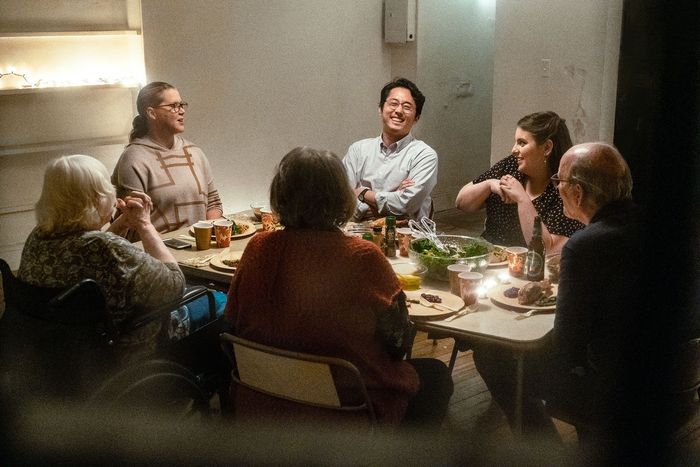
For your sake, I hope you do not have a Thanksgiving like the one in The Humans.
This is not a knock on the film, written and directed by Stephen Karam and based on his Tony Award–winning play about multiple generations gathering in a sagging Chinatown apartment for their annual turkey feast. The Humans, in theaters today and also airing tonight on Showtime, is an observant study of the things we share and suppress among family, and what we sacrifice when life jump-scares us with the unexpected. Karam has translated his stage work into a film that never feels static. It lives somewhere in the genre space between indie drama and thriller, smack-dab between the surreal and the all too real.
Which is to say that this portrait of the Blake family rings with authenticity, but isn’t exactly uplifting. This Thanksgiving tale has no Planes, Trains and Automobiles or even Pieces of April vibes. But while, spoiler alert, there is no happy ending for The Humans, there is the satisfaction of watching a work of art that is carefully conceived and stays faithful to its vision.
As the film begins, members of the Blake family are convening at the New York City apartment into which Brigid (Beanie Feldstein) and her boyfriend Richard (Steven Yeun) have recently moved, a two-level place with a noticeable lack of furniture, décor, and fresh light bulbs. Brigid’s dad, Erik (Richard Jenkins), is immediately concerned about his daughter’s safety, and the camera follows his cautious eye to the bulges in the drywall, seemingly caused by leaking pipes, and the narrow windows that offer views of the bleak alley below that Brigid refers to as “an interior courtyard.” That description cracks up Deirdre, Brigid’s mom (Jayne Houdyshell, reprising the role that won her a Tony), who is prone to sudden laughter but grows more somber when she’s alone. Brigid’s sister Aimee (Amy Schumer), who recently lost her partner and her job and is dealing with ulcerative colitis, meanwhile, rarely smiles. And then there’s Erik’s mother, Momo (June Squibb), who is wheelchair-bound and frozen by dementia, which makes her largely uncommunicative until she has unexpected outbursts.
Unexpected outbursts are a running thread in The Humans, and not all of them come from the people assembled for dinner. Odd clanks and bangs emanate from the apartment itself, as well as the allegedly noisy neighbor who lives above Brigid and Richard. The film’s sound design amps up those audio interruptions, and then sometimes deliberately turns the volume down on conversations in one room while the lens peers into another, turning we, the audience, into eavesdroppers. It’s a clever touch for a stage-to-screen adaptation that, even on film, effectively makes us feel like we’re sharing the same dank, dimly lit space with these characters.
The way certain Blake family members respond to all the rattling tells us something about them. Brigid, who is determined to stay in New York and continue pursuing a career as a composer, dismisses the sounds in front of her father, who thinks she would be better off having a more traditional job and living back home in Scranton, Pennsylvania. Erik, on the other hand, is genuinely unnerved by the noise and his jumpiness unnerves us. Their responses both speak to a desire for control in their life; Brigid seeks to impose it through sheer force of will. Erik appears to be losing it entirely, for reasons that won’t crystallize until closer to the movie’s end.
For a good portion of The Humans, there is no singular, obvious conflict in the narrative. But the presence of potential conflict is always there, hovering around the corners of every scene. While the film is quote-unquote talky, the things that the Blakes won’t say — the secrets we learn they are keeping from each other — are as vital to the film as their spoken dialogue. Touchy subjects — religion, finances, alcohol consumption — creep around the edges of conversations, and all of the actors have an innate sense of how quickly the passive-aggressive can turn aggressive. Several of the characters, most notably Deirdre, experience moments in which they privately break down, but only we are there to witness it. Their sorrows, like all sorrows, are more heartbreaking once you realize how hard these people are trying to hide them.
The idea that everyone in this family is simultaneously close to and far away from each other comes through in the way that Karam plays with distances in The Humans. Often the camera will close in on details within the physical environment — a water stain on a ceiling, stuffing being mixed in a bowl — but the human beings are almost always captured in wide shots that obscure the finer details in their expressions. Occasionally, Karam and cinematographer Lol Crawley distort our view by capturing reflections through fractured glass or views of hallways that appear narrower than a No. 2 pencil. All of it creates a sense that this apartment might be haunted.
But it’s not the place that’s haunted. It’s the people. While the Blakes’ Thanksgiving is probably not one that any of us aspire to mirror, it may be all too recognizable. That’s, admittedly, a little depressing. But in the hands of Karam and this gifted cast, there is beauty in that, too.
More Movie Reviews
- The Thriller Drop Is a Perfect Addition to the Bad-First-Date Canon
- The Accountant 2 Can Not Be Taken Seriously
- Another Simple Favor Is So Fun, Until It Gets So Dumb


